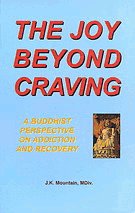The Joy Beyond Craving: A Buddhist Perspective on Addiction and Recovery

Chapter headings:
- Introduction
- Part 1: The Four Noble Truths
- The First Noble Truth: Life is a bitch, and then you die!
- The Second Noble Truth: If you think you have to have it, then it really has you!
- The Third Noble Truth: Nirvana is the joy of being where you are and loving what is here and now!
- The Fourth Noble Truth: There is a way!
- Part 2: The Twelve Steps
- Step One; Step Two; etc…
- Conclusion
- Annotated bibliography
Selected excerpts:
“We’ve seen that the cause of our suffering lies not merely in external events, but in our own thoughts and actions, based on our false concept of ourselves as independent entities. Turning our lives over to our Higher Consciousness constitutes letting go of that self-image, to recognize our oneness with the Emptiness of Ultimate Being.”
“Mystics of all religions have said that the way to find Spiritual Awakening is to open ourselves completely through prayer and meditation, and listen to the still inner voice. Then in Divine Ecstasy, when the distinction between our Higher Consciousness and ourselves disappears, it does so not because we absorb that Consciousness into ourselves, but because we put aside our illusory idea of “self” and become absorbed in the Divine Emptiness completely. This is the spiritual Awakening of which both Bill W. and the Buddha spoke.” (p. 112)
© 2003 Desert Wordsmith Productions
Order this book online at Amazon
Reviews posted:
Paul –
This slim volume takes us through the Four Noble Truths, and then re-formulates the Twelve Steps of AA in a Buddhist context, changing the language to be more accommodating of different religious backgrounds and dependencies. One of her strengths as a Master of Divinity is her keen appreciation of the diversity of religious and spiritual practice. Thus her sensitivity to issues that might alienate people is very keen. I agree with her that “dull, technical and hard to follow” books on Buddhism abound, and applaud the attempt at a short, simple, accessible account. The old joke “I would have written a shorter letter but I didn’t have time” points to the essential problem here: she has in fact attempted the very hardest thing. Conveying Buddhist doctrines such as ‘no-self’ in so few words is a challenge. For the newcomer to Buddhism and recovery, I am unsure such a bald statement will be that convincing. It lacks the examples, anecdotes, and stories that Griffin for example uses to such great effect to soften our preconceptions and bring to life ‘a Buddhist perspective on addiction and recovery’. For this reason I think Griffin’s book is the better starting point. This shouldn’t detract from the fact that The Joy Beyond Craving makes interesting reading for those trying to reconcile AA and Buddhism.
Michael –
This small book provides the author’s attempt to re-work the language of the Twelve Steps of AA from a Buddhist point of view. she looks at the Four Noble Truths in relationship to addiction before addressing each step in turn. The author demonstrates well her understanding and qualifications in conveying the steps in the language of Buddhism. Though other books have discussed a Buddhist approach to the Twelve Steps as they currently exist, no other work had undertaken to change the original wording of the steps. Although at times I did get the sense that maybe she took spiritual correctness a touch too far in her explicit desire to not alienate others (it is after all near impossible to be all things to all people), her work nonetheless provided me with further understanding, clarity, and deeper insight into combining what is ultimately the heart of recovery with the spirit of Buddhism. Whilst the language of the book is quite clear and simply conveyed, I do feel this book would ultimately be best utilized by those who already have some experience in both Buddhist and Twelve Step practice. It’s not a book that takes a broader Buddhist approach to addiction, but in its attempt to portray the Twelve Steps translated into a predominately Buddhist version of the same, I believe it fills a unique but important gap left by others and well lives up to its basic intention.
